Martin Van Buren Worksheets
Do you want to save dozens of hours in time? Get your evenings and weekends back? Be able to teach about Martin Van Buren to your students?
Our worksheet bundle includes a fact file and printable worksheets and student activities. Perfect for both the classroom and homeschooling!
Resource Examples
Click any of the example images below to view a larger version.
Fact File
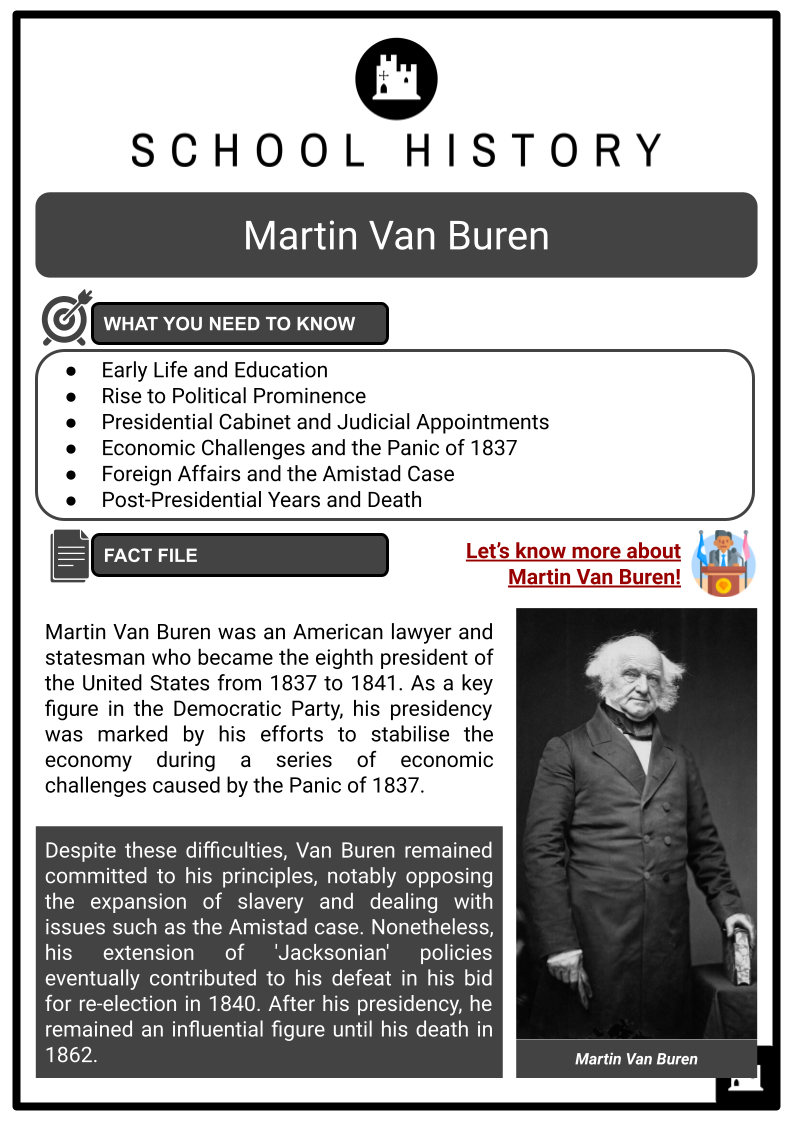
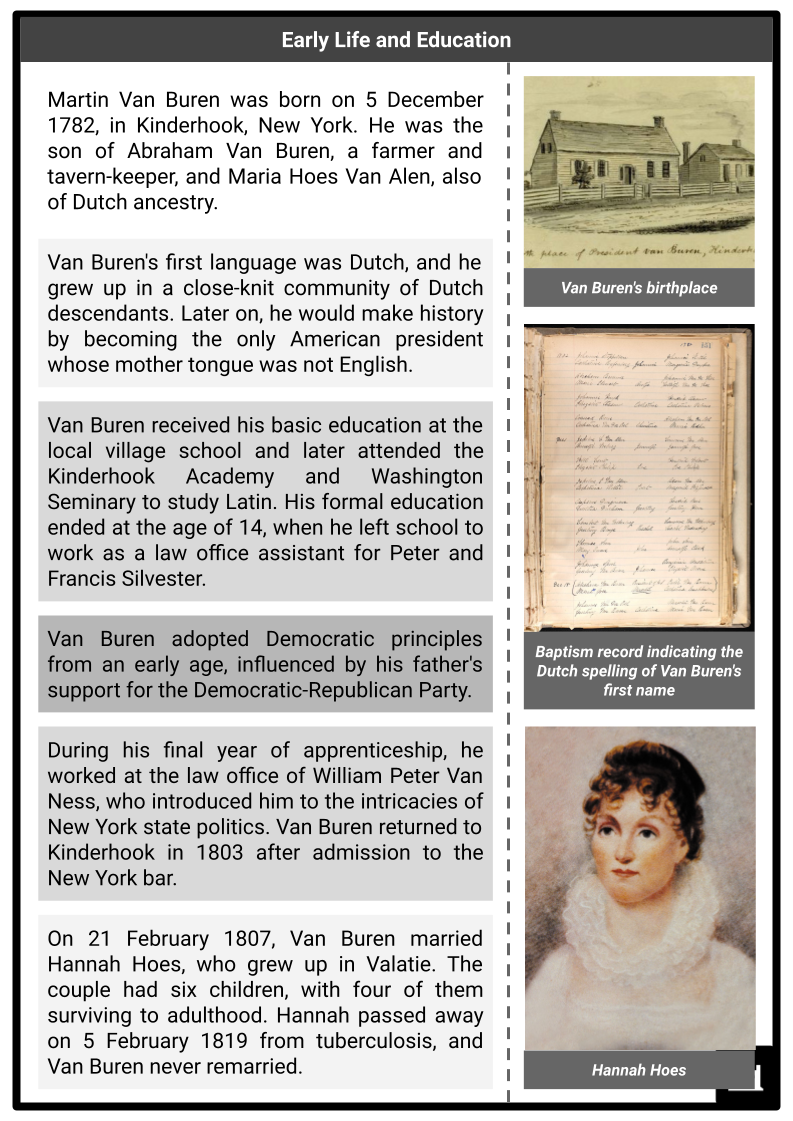
Student Activities
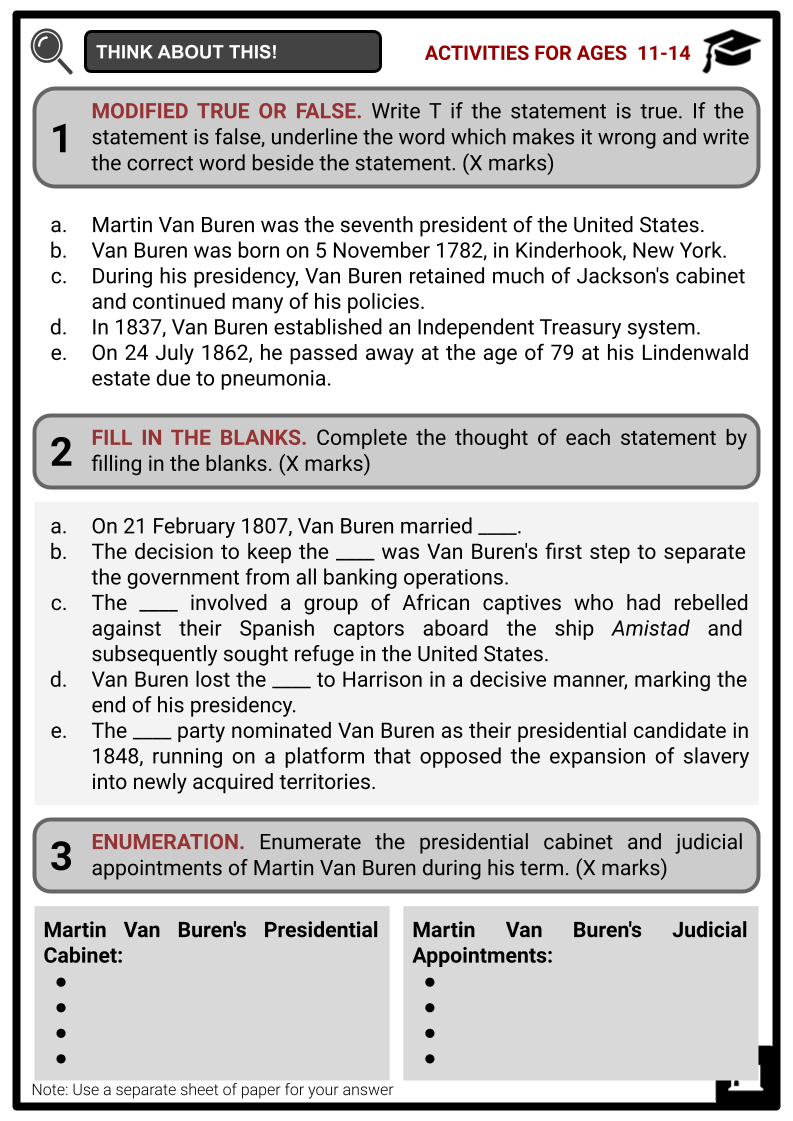
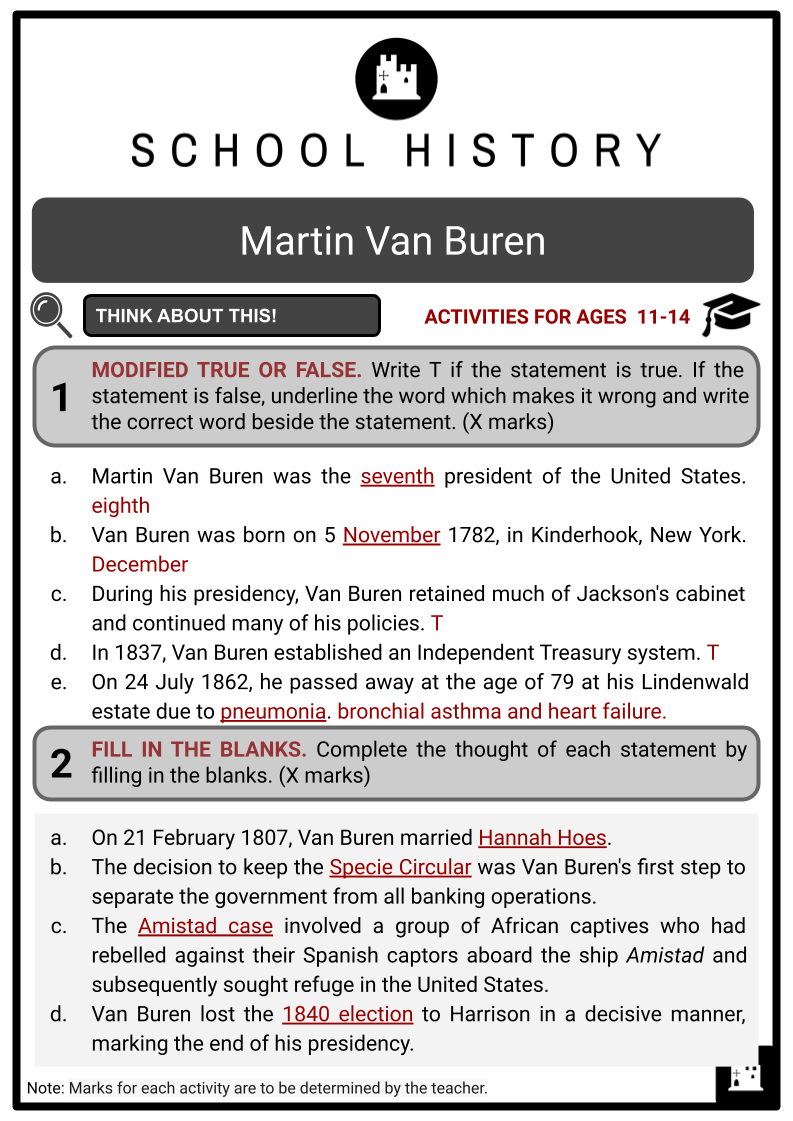
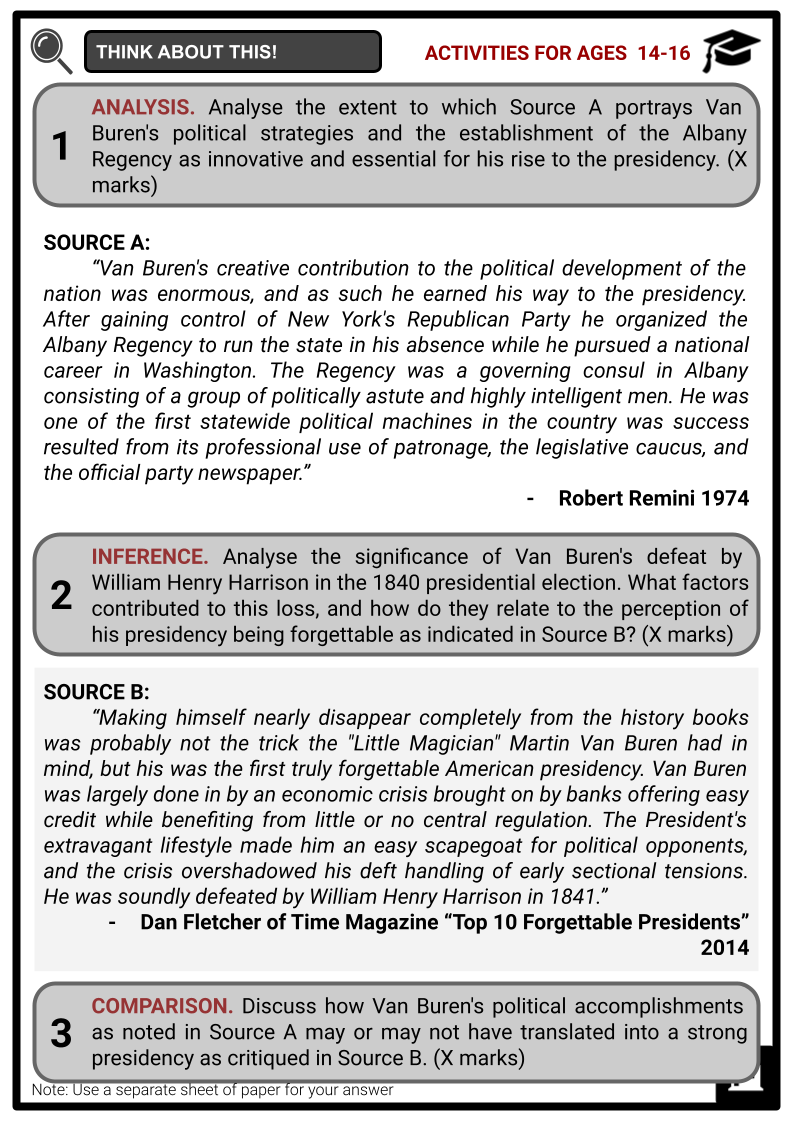
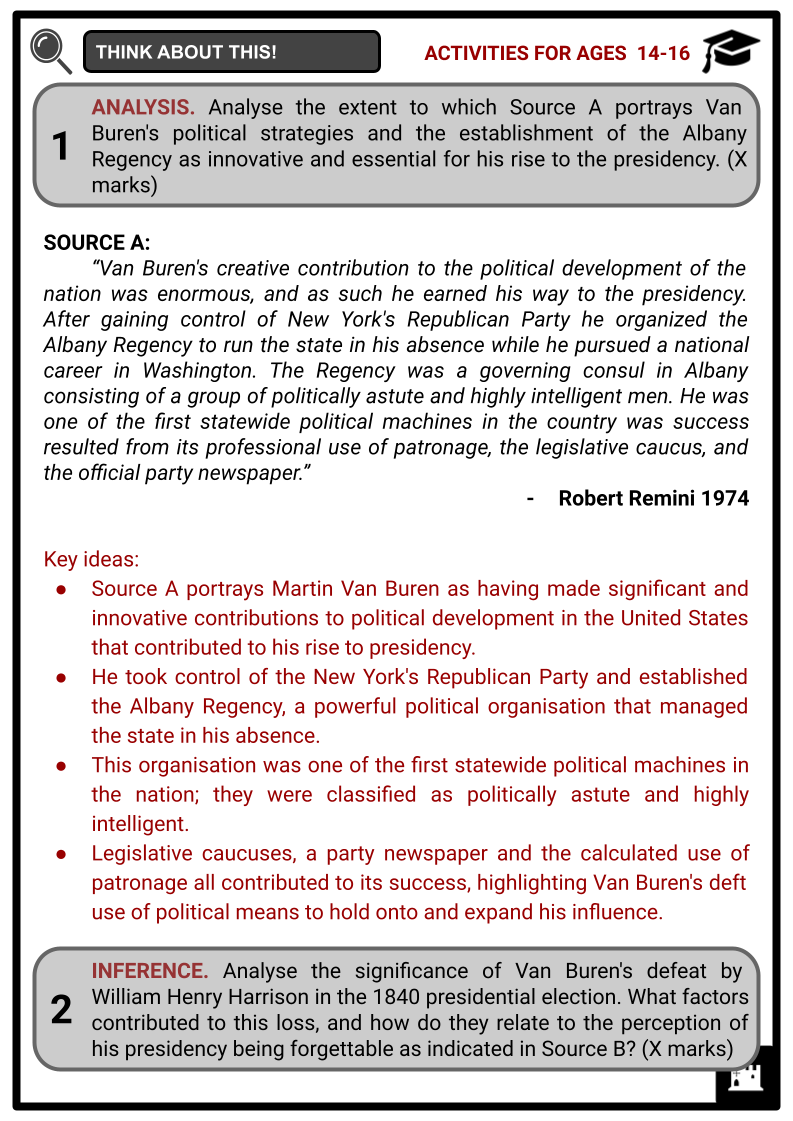
Summary
- Early Life and Education
- Rise to Political Prominence
- Presidential Cabinet and Judicial Appointments
- Economic Challenges and the Panic of 1837
- Foreign Affairs and the Amistad Case
- Post-Presidential Years and Death
Key Facts And Information
Let’s know more about Martin Van Buren!
Martin Van Buren was an American lawyer and statesman who became the eighth president of the United States from 1837 to 1841. As a key figure in the Democratic Party, his presidency was marked by his efforts to stabilise the economy during a series of economic challenges caused by the Panic of 1837.
Despite these difficulties, Van Buren remained committed to his principles, notably opposing the expansion of slavery and dealing with issues such as the Amistad case. Nonetheless, his extension of 'Jacksonian' policies eventually contributed to his defeat in his bid for re-election in 1840. After his presidency, he remained an influential figure until his death in 1862.
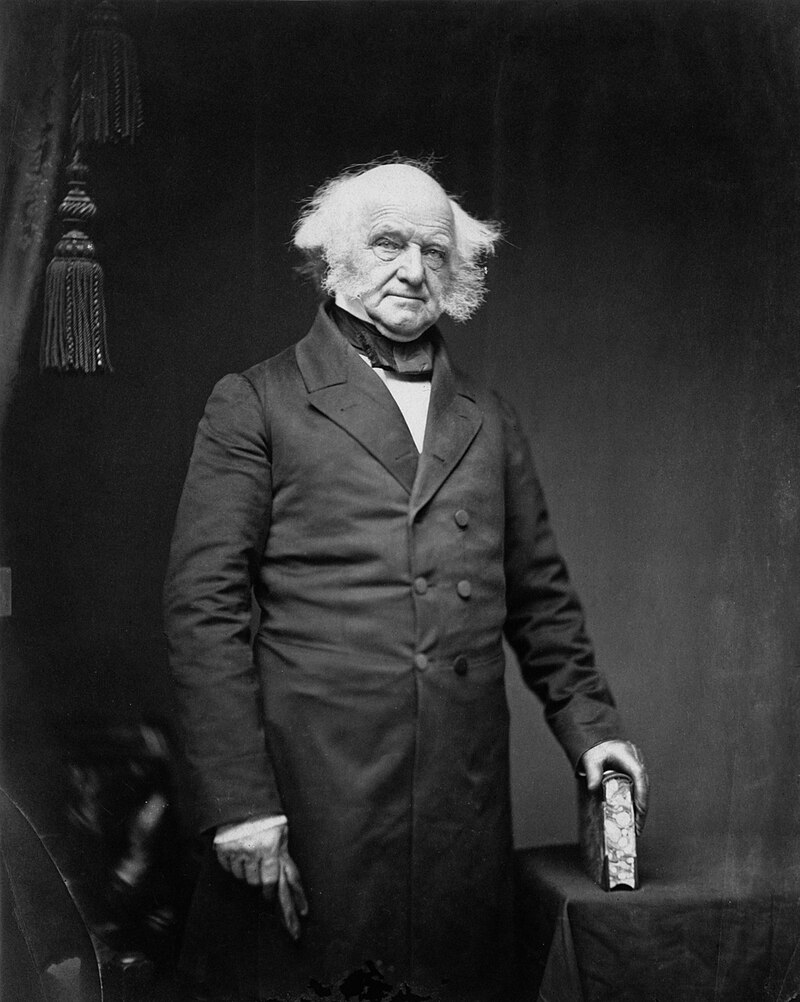
Early Life and Education
- Martin Van Buren was born on 5 December 1782, in Kinderhook, New York. He was the son of Abraham Van Buren, a farmer and tavern-keeper, and Maria Hoes Van Alen, also of Dutch ancestry.
- Van Buren's first language was Dutch, and he grew up in a close-knit community of Dutch descendants. Later on, he would make history by becoming the only American president whose mother tongue was not English.
- Van Buren received his basic education at the local village school and later attended the Kinderhook Academy and Washington Seminary to study Latin. His formal education ended at the age of 14, when he left school to work as a law office assistant for Peter and Francis Silvester.
- Van Buren adopted Democratic principles from an early age, influenced by his father's support for the Democratic-Republican Party.
- During his final year of apprenticeship, he worked at the law office of William Peter Van Ness, who introduced him to the intricacies of New York state politics. Van Buren returned to Kinderhook in 1803 after admission to the New York bar.
- On 21 February 1807, Van Buren married Hannah Hoes, who grew up in Valatie. The couple had six children, with four of them surviving to adulthood. Hannah passed away on 5 February 1819 from tuberculosis, and Van Buren never remarried.
Rise to Political Prominence
1801
- Martin Van Buren attended a meeting of the Democratic-Republican Party in Troy, New York, marking the beginning of his involvement in politics.
1812
- He was elected to the New York State Senate.
- During the War of 1812, he collaborated with Clinton, Governor Tompkins and Ambrose Spencer to endorse the Madison administration's efforts in prosecuting the war. He also collaborated with Winfield Scott and Secretary of War John Armstrong Jr to recruit and supply troops in New York.
1815
- His contribution to the war effort gained him recognition and popularity, leading to his election as the Attorney General of New York.
1816
- He won re-election to the state senate.
- He would maintain his roles as both a state senator and the state's attorney general at the same time.
1821
- He was elected to represent New York in the United States Senate.
- During his tenure in the Senate, he held the position of chairman for both the Senate Finance Committee and the Senate Judiciary Committee.
- He established the Albany Regency, a political alliance that aimed to unite different factions within the Democratic-Republican Party.
1828
- He helped arrange the passage of the Tariff of 1828, which benefited Northern manufacturers but angered Southern states due to its protective measures.
1829
- He resigned from the Senate and started his term as Governor of New York.
- However, after Andrew Jackson won the 1828 US presidential election, Van Buren resigned from his position as governor in order to serve as Jackson's secretary of state.
1831
- He was given by Jackson a recess appointment as ambassador to Great Britain.
- However, he was rejected by the Senate, particularly John C Calhoun, the year after.
1832
- He won the nomination to serve as vice president of the Democratic Party alongside Jackson.
1833
- He won the 1832 elections by a landslide.
- He took office as the Vice President of the United States, serving alongside President Andrew Jackson.
1837
- Jackson declined to seek another term, paving the way for Van Buren to run as the Democratic Party's candidate for president in the 1836 elections.
- Van Buren won the elections and was inaugurated as the eighth President of the United States.
Presidential Cabinet and Judicial Appointments
- During his presidency, Van Buren retained much of Jackson's cabinet and continued many of his policies. This was due to his desire to stop the Southern Whigs' momentum and rebuild trust in the Democratic Party.
- Martin Van Buren's Cabinet Members:
- Secretary of State: John Forsyth
- Secretary of the Treasury: Levi Woodbury
- Secretary of War: Joel R Poinsett
- Attorney General: Felix Grundy
- Secretary of the Navy: Mahlon Dickerson
- Postmaster General: Amos Kendall
- His judicial appointments were notable for their choice of Democratic-Republicans who aligned with his political beliefs.
- In total, he appointed three justices to the Supreme Court and eight judges to the lower federal courts.
- Appointed Supreme Court Justices:
- John Catron
- John McKinley
- Peter V Daniel
- Appointed District Court Judges:
- Philip Kissick Lawrence
- Samuel J Gholson
- Isaac S Pennybacker
- John Cochran Nicoll
- Robert Budd Gilchrist
- Mahlon Dickerson
- Philemon Dickerson
- John Y Mason
Economic Challenges and the Panic of 1837
- Van Buren's term as the eighth President of the United States consisted of significant economic challenges, most notably the Panic of 1837. The Panic of 1837 was a financial crisis that resulted from a combination of factors:
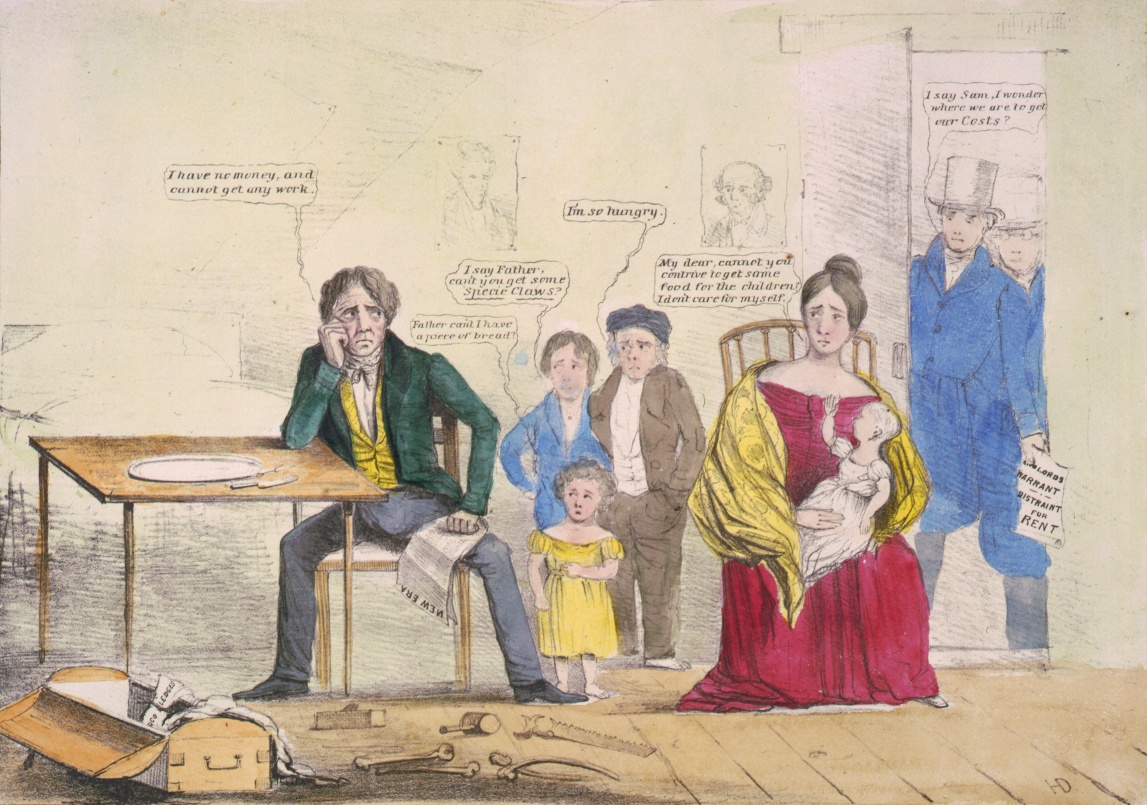
- Speculative Bubble: The period preceding the Panic saw a speculative frenzy in land and property, particularly in the western states. This speculative bubble led to inflated prices and excessive borrowing, creating an unsustainable economic situation.
- Bank Failures: The rapid expansion of state-chartered banks and their issuance of paper currency without proper regulation contributed to the instability of the financial system. When the speculative bubble burst, many of these banks failed, leading to a widespread loss of confidence in the banking system.
- Dismantling of the Second Bank of the United States: Andrew Jackson, Van Buren's predecessor, had vetoed the recharter of the Second Bank of the United States, effectively dismantling it in 1833. This decision contributed to the economic instability, as the absence of a central bank made it more difficult to control the flow of currency and stabilise the economy.
- Specie Circular: President Jackson's issuance of the Specie Circular in 1836, which required payment for public lands to be made in gold and silver, caused a drain on the nation's reserves of specie and contributed to a credit crunch and further economic turmoil.
- International Factors: Economic problems in Europe, particularly in England, also played a role in the Panic of 1837. A contraction in British credit and a downturn in the English economy had repercussions in the United States, leading to a reduction in investment and trade.
- Overexpansion: The economic growth and land speculation in the west outpaced the actual development and productivity of the region. This overexpansion left many individuals and businesses highly leveraged and vulnerable to economic shocks. In response to the economic downturn, Van Buren focused on the practice of financial regulation and fiscal restraint. He refused to revoke the Specie Circular for fear that it would further destabilise the financial system. He hesitated to deviate from a Jacksonian approach.
- The decision to keep the Specie Circular was Van Buren's first step to separate the government from all banking operations. In 1837, he established an independent Treasury system, also known as the subtreasury system, to maintain government funds in its own vaults, separate from the private banks. This move was seen as an attempt to stabilise the economy and prevent future financial crises by reducing the reliance on a national bank.
- Despite his efforts, the economic downturn persisted, leading to widespread unemployment and business failures. Van Buren's response to the Panic of 1837 was met with mixed reactions. He faced opposition from the conservative Democrats, who favoured the use of a national bank, and the newly formed Whig Party, which sought to challenge the dominance of the Democratic Party.
- A coalition of Whigs and Democrats revoked the Specie Circular in 1838. A surplus of cotton led to the start of the Panic of 1839, the second economic crisis. Bank failures occurred, industries laid off workers, land prices crashed, and the cotton trade stopped producing as much revenue. Van Buren's Independent Treasury proposal was passed by Congress in June 1840, in part as a reaction to this second economic depression. On the other hand, the Independent Treasury system was set to be abolished by the Whigs in 1841, but it was resurrected in 1846 and continued until the Federal Reserve Act was passed in 1913.
Foreign Affairs and the Amistad Case
- During his presidency, Van Buren's foreign policy focused on maintaining diplomatic relations and navigating international issues, particularly in the Western Hemisphere. His administration navigated relations with the Republic of Texas, which had declared independence from Mexico in 1836.
- The issue of Texas annexation and its implications for the balance of power and the institution of slavery shaped diplomatic discussions with Mexico and other nations. Rejecting Jackson's threat to use force to settle a long-running financial dispute between the American people and the Mexican government, Van Buren offered a diplomatic alternative.
- Tensions along the border with Canada were also a significant concern during Van Buren's presidency. Incidents of violence and conflict between settlers and authorities from both the United States and Canada were not uncommon.
- One notable event was the Aroostook War, also known as the Pork and Beans War, which occurred in 1838–1839 and involved tensions over the boundary between the United States state of Maine and the British Canadian province of New Brunswick. The dispute escalated to the point where both sides mobilised troops, leading to a brief but intense stand-off.
- In response to these border violences, Van Buren sought diplomatic solutions to ease tensions and prevent further escalation. He worked closely with the British government to negotiate, establish clearer border demarcations, and address the underlying issues that led to the conflicts. His administration managed to avoid a full-scale confrontation with Canada.
- Another notable event of Van Buren's presidency that concerned his administration's foreign affairs was the Amistad case in 1839. The case involved a group of African captives who had rebelled against their Spanish captors aboard the ship Amistad and subsequently sought refuge in the United States. Upon their arrival in the United States, the African captives were imprisoned and faced legal proceedings to determine their fate.
- Van Buren's administration initially supported the position of Spain, which claimed the Africans as their property and demanded their return. However, abolitionists and anti-slavery advocates rallied behind the cause of the Amistad captives, arguing for their freedom and protection from being unlawfully enslaved.
- Van Buren's administration faced the challenge of determining whether the Africans should be considered salvage from the vessel or, as they argued, free individuals who had been wrongfully enslaved. The case eventually reached the US Supreme Court, where former President John Quincy Adams passionately defended the rights of the Amistad captives.
- In a landmark decision, the court ruled in favour of the Africans, affirming their status as free individuals and rejecting the claims of the Spanish government. The outcome of the Amistad case was a significant victory for the abolitionist movement and a powerful statement against the institution of slavery.
- Van Buren's handling of the Amistad case reflected the complexities of his administration's foreign policy and his approach to domestic issues, particularly regarding the contentious matter of slavery.
- His administration's initial stance aligned with diplomatic considerations and international relations with Spain, but the eventual legal resolution underscored the broader moral and humanitarian dimensions that transcended national borders.
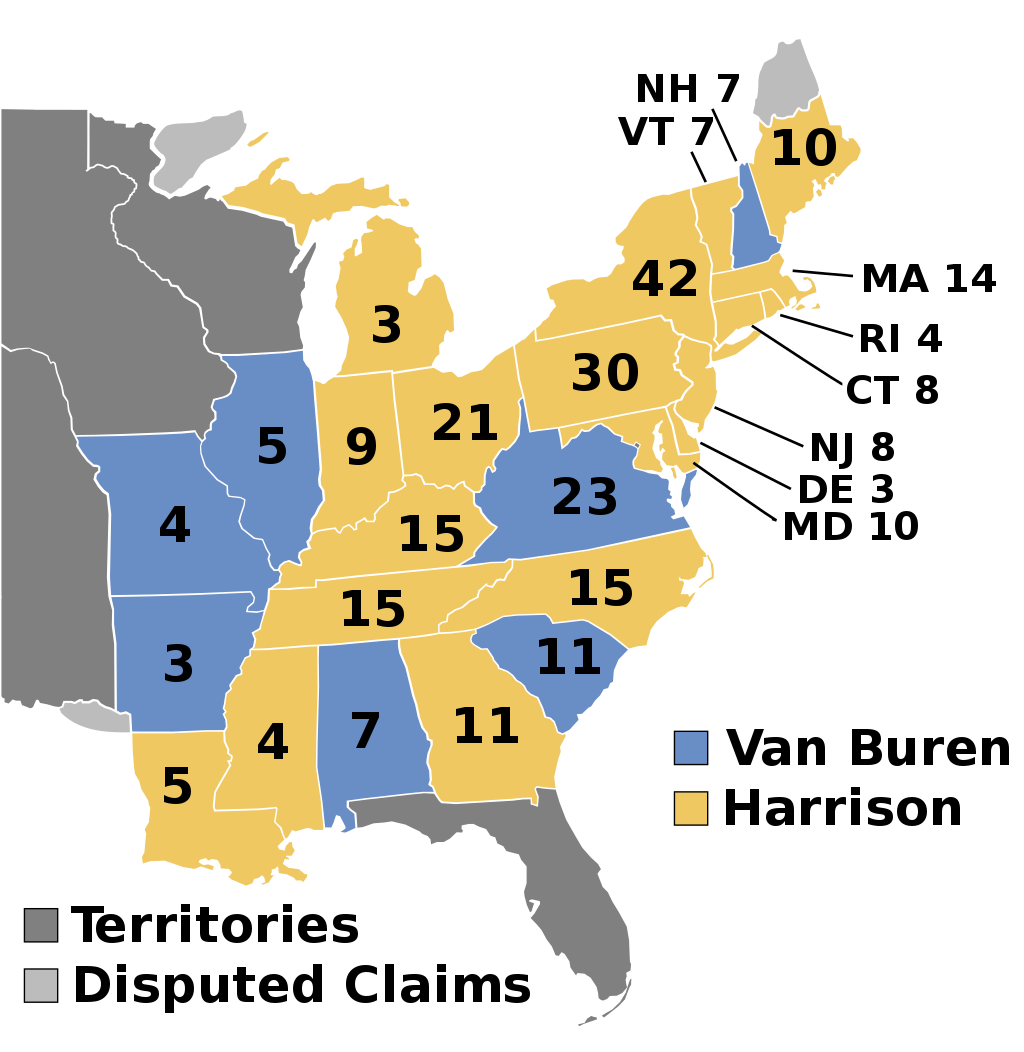
Post-Presidential Years and Death
- In Baltimore, Maryland, during the Democratic National Convention in 1840, Van Buren comfortably secured renomination for a second term. However, as the 1840 presidential election approached, Van Buren faced an uphill battle for re-election. Due to the severe economic downturn the country was experiencing during his presidency, as well as other contentious issues like slavery, western expansion and tensions with Great Britain, Van Buren's political opponents – including some of his fellow Democrats – had ample opportunity to criticise his policies.
- The Whigs nominated war hero William Henry Harrison, known for his populist appeal and campaign slogans. Harrison's message resonated with the electorate, and he successfully portrayed Van Buren as out of touch with the economic struggles of the common people. Ultimately, Van Buren lost the 1840 election to Harrison in a decisive manner, marking the end of his presidency.
- Following his presidency, Van Buren's popularity and political skills made him a prominent figure in the lead-up to the election of 1844. Despite initial expectations that he would secure the Democratic Party's nomination for the presidency, Van Buren faced opposition due to his stance on the annexation of Texas. His reluctance to annex Texas, driven by concerns over the potential expansion of slavery, led to a division within the Democratic Party. As a result, Van Buren lost the party's nomination to James K Polk, a proponent of Texas annexation.
- His influence continued to be felt in the political landscape leading up to the election of 1848. By this time, the issue of slavery had become increasingly contentious, and it played a central role in the formation of new political alliances. Van Buren, along with other anti-slavery Democrats and members of the existing Whig Party, joined forces to establish the Free Soil Party.
- This new party nominated Van Buren as their presidential candidate in 1848, running on a platform that opposed the expansion of slavery into newly acquired territories. Unfortunately, he did not win the presidency. After the election of 1848, he gradually withdrew from active participation in politics and returned to Kinderhook, where he focused on agricultural pursuits and his personal writings.
- Van Buren's health began to deteriorate in 1861 as he was bedridden with pneumonia. On 24 July 1862, he passed away at the age of 79 at his Lindenwald estate due to bronchial asthma and heart failure.
- He is interred in the Kinderhook Reformed Dutch Church Cemetery alongside his parents, son Martin Van Buren Jr, and wife Hannah. Harrison, Tyler, Polk and Taylor were his four immediate successors, but he outlived them all. Furthermore, he witnessed the election of eight successors to the presidency – more than any other person – and lived to witness Abraham Lincoln's election as the 16th President prior to his passing.
Image Sources
- https://upload.wikimedia.org/wikipedia/commons/thumb/1/1f/Martin_Van_Buren_by_Mathew_Brady_c1855-58.jpg/800px-Martin_Van_Buren_by_Mathew_Brady_c1855-58.jpg
- https://upload.wikimedia.org/wikipedia/commons/9/95/Panic1837.jpg
- https://upload.wikimedia.org/wikipedia/commons/thumb/c/c4/ElectoralCollege1840.svg/1024px-ElectoralCollege1840.svg.png
Frequently Asked Questions
- Who was Martin Van Buren?
Martin Van Buren was the 8th President of the United States, serving from 1837 to 1841. He was also the eighth Vice President under Andrew Jackson from 1833 to 1837.
- What were some of Martin Van Buren's notable achievements?
Van Buren's presidency saw the establishment of the Independent Treasury System, which aimed to stabilise the economy by keeping federal funds in government vaults rather than banks. He also played a pivotal role in developing the modern two-party system in American politics.
- What was Martin Van Buren's stance on slavery?
Van Buren was a complex figure in terms of slavery. While he opposed slavery, his political manoeuvres often prioritised maintaining party unity over advancing abolitionist causes. His presidency was marked by attempts to appease both the Northern and Southern factions of the Democratic Party, which sometimes resulted in policies seen as compromising on slavery-related issues.
